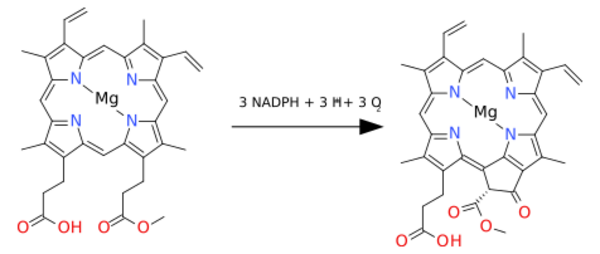Biology:Magnesium-protoporphyrin IX monomethyl ester (oxidative) cyclase
| Magnesium-protoporphyrin IX monomethyl ester (oxidative) cyclase | |||||||||
|---|---|---|---|---|---|---|---|---|---|
| Identifiers | |||||||||
| EC number | 1.14.13.81 | ||||||||
| CAS number | 92353-62-3 | ||||||||
| Databases | |||||||||
| IntEnz | IntEnz view | ||||||||
| BRENDA | BRENDA entry | ||||||||
| ExPASy | NiceZyme view | ||||||||
| KEGG | KEGG entry | ||||||||
| MetaCyc | metabolic pathway | ||||||||
| PRIAM | profile | ||||||||
| PDB structures | RCSB PDB PDBe PDBsum | ||||||||
| |||||||||
Magnesium-protoporphyrin IX monomethyl ester (oxidative) cyclase (EC 1.14.13.81), is an enzyme with systematic name magnesium-protoporphyrin-IX 13-monomethyl ester, ferredoxin:oxygen oxidoreductase (hydroxylating).[1] In plants this enzyme catalyses the following overall chemical reaction

- magnesium-protoporphyrin IX 13-monomethyl ester + 3 NADPH + 3 H+ + 3 O2 divinylprotochlorophyllide + 3 NADP+ + 5 H2O (overall reaction)
Recent evidence[2] shows that the necessary electrons which cycle the enzyme from oxidised to reduced form come from ferredoxin. In green tissue, ferredoxin can receive these electrons directly from photosystem I so that NADPH need not be involved. However, in the dark, ferredoxin can also be reduced via Ferredoxin—NADP(+) reductase, allowing the reaction to proceed in that case. It is therefore more accurate to show the individual steps as follows:
- (1a) magnesium-protoporphyrin IX 13-monomethyl ester + 2 reduced ferredoxin + O2 131-hydroxy-magnesium-protoporphyrin IX 13-monomethyl ester + H2O
- (1b) 131-hydroxy-magnesium-protoporphyrin IX 13-monomethyl ester + 2 reduced ferredoxin + O2 131-oxo-magnesium-protoporphyrin IX 13-monomethyl ester + 2 H2O
- (1c) 131-oxo-magnesium-protoporphyrin IX 13-monomethyl ester + 2 reduced ferredoxin + O2 divinylprotochlorophyllide + 2 H2O
This enzyme requires Fe(II) for activity. In barley the cyclase protein is named XanL and is encoded by the Xantha-l gene. An associated protein, Ycf54, seems to be required for proper maturation of the XanL enzyme,[2] which is part of the biosynthetic pathway to chlorophylls.[3][4][5] In anaerobic organisms such as Rhodobacter sphaeroides the same overall transformation occurs but the oxygen incorporated into magnesium-protoporphyrin IX 13-monomethyl ester comes from water in the reaction EC 1.21.98.3.[6]
See also
References
- ↑ "The Chlorophyll Biosynthetic Enzyme Mg-Protoporphyrin IX Monomethyl Ester (Oxidative) Cyclase (Characterization and Partial Purification from Chlamydomonas reinhardtii and Synechocystis sp. PCC 6803)". Plant Physiology 112 (1): 105–114. September 1996. doi:10.1104/pp.112.1.105. PMID 12226378.
- ↑ 2.0 2.1 "Aerobic Barley Mg-protoporphyrin IX Monomethyl Ester Cyclase is Powered by Electrons from Ferredoxin" (in en). Plants 9 (9): 1157. 2020-09-08. doi:10.3390/plants9091157. PMID 32911631.
- ↑ "Biosynthesis of chlorophylls from protoporphyrin IX". Natural Product Reports 20 (3): 327–41. June 2003. doi:10.1039/B110549N. PMID 12828371.
- ↑ "Recent advances in chlorophyll biosynthesis". Photosynthesis Research 90 (2): 173–94. November 2006. doi:10.1007/s11120-006-9076-6. PMID 17370354.
- ↑ Tanaka, Ryouichi; Tanaka, Ayumi (2007). "Tetrapyrrole Biosynthesis in Higher Plants". Annual Review of Plant Biology 58: 321–346. doi:10.1146/annurev.arplant.57.032905.105448. PMID 17227226.
- ↑ Porra, Robert J.; Schafer, Wolfram; Gad'On, Nasr; Katheder, Ingrid; Drews, Gerhart; Scheer, Hugo (1996). "Origin of the Two Carbonyl Oxygens of Bacteriochlorophyll a. Demonstration of two Different Pathways for the Formation of Ring e in Rhodobacter sphaeroides and Roseobacter denitrificans, and a Common Hydratase Mechanism for 3-acetyl Group Formation". European Journal of Biochemistry 239 (1): 85–92. doi:10.1111/j.1432-1033.1996.0085u.x. PMID 8706723.
 |

